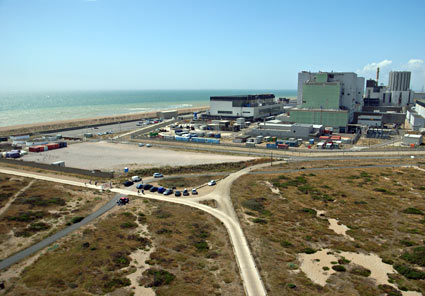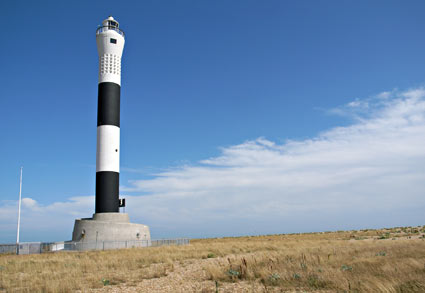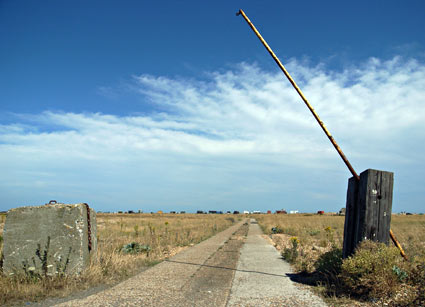The bleak beauty of Dungeness
A summer afternoon in the most southerly point in Kent
Photos and report by Mike Slocombe, July 2006
One of the largest expanses of shingle in the world, the area around Dungeness plays host to a small village, two nuclear power stations, the world's smallest public railway and an important ecological site.
Designated a National Nature Reserve (NNR), Special Protection Area (SPA) and Special Area of Conservation (SAC), Dungeness is of international importance because of its geomorphology, plant and invertebrate communities and birdlife.
The area supports over 600 different types of plant as well as rare moths, bees, beetles and spiders, some unique to the area.
Two of Dungeness's five lighthouses still survive, but only the smart 1961 one is in use.

Station sign with the 1901 lighthouse in the background.
The railways
Dungeness was originally served by a short branch from the South Eastern Railway's line from Appledore to New Romney, which closed to passengers on 4 July 1937.
The Lydd to New Romney section closed for good on 6 March 1967, although the line to Lydd is still used to transport waste from the nuclear power stations.
Many of the shacks scattered around the south end of Dungeness arrived in the 1920s when Southern Railway workers purchased old rolling stock which were dragged off the end of the line to be used as holiday shacks.
The 15 inch (380 mm) gauge Romney, Hythe and Dymchurch Railway arrived at Dungeness in 1928, a year after the line reached New Romney and still serves the area.

The shingle flats around Dungeness are scattered with little huts, sheds and shacks in various states of repair.
The village
Dungeness is more of a scattered collection of dwellings than a village, with a selection of huts, wooden sheds, corrugated iron constructions and some brick built homes seemingly randomly distributed over the shingle.
Many of the homes are owned by and lived in by fishermen, whose boats lie improbably long distances from the sea, hoisted high on the shingle banks.
The remote location has also made it popular with people wanting to get away from it all, with one of Dungeness's most famous residents being the late artist and film director Derek Jarman.

Arriving at Dungeness station on the Romney, Hythe and Dymchurch Railway


Station cafe.


Small hut.

Dungeness power stations, as seen from the top of the 1901 lighthouse.


Remains of the old South Eastern Railway station at Dungeness.

Memorial to two WW2 Polish Spitfire pilots who were shot down and killed nearby in April 1941.

Romney, Hythe and Dymchurch Railway track and sign.


To the Sea.

A view of the 1961-built lighthouse, the fifth to be built in the area and still operational.

Fisherman on the shingle beach.


Strange wooden construction that appears to have no purpose.

Another view, with the two lighthouses visible either side in the distance.

Airstream trailer and all-black wooden house.


Road to nowhere.

Old digger and hut.

|
|

